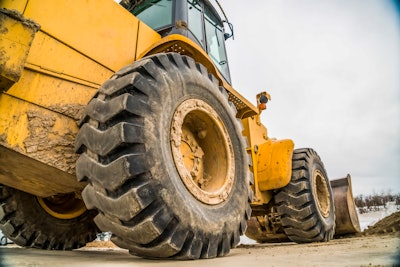
Construction sites can be hazardous and unruly places which makes for variation as far as construction equipment and their tire needs go. Choosing the correct type of tire can come down to factors like terrain, weight, and intended use of the equipment.
The most common issue narrows to solid versus pneumatic tires. These tires are built with different strengths and can endure different difficulties. Between solid tires and pneumatic tires, it can be a matter of environment and need when deciding what’s right for you.
Pneumatic Tires
Pneumatic tires are like your classic everyday tires - they are filled with compressed air and are quite versatile. Pneumatic tires are shock-absorbent and capable of being used in most environments, but they are most ideal when used in environments clear of sharp objects and debris.
Pneumatic tires are often used to navigate uneven surfaces since they are quite useful when you need good traction and better tread. The shock-absorbent nature of these tires makes them a popular choice for outdoor use due to their smoother ride - even over rough and bumpy terrain.
Solid Tires
Solid tires are older than their pneumatic counterpart. Although they are older, they are not outdated. Solid tires are made without air and are instead made up of layers of rubber. This is ideal when working on hazardous construction sites where nails or debris could be covering the ground. They are also ideal for uneven surfaces.
Solid tires are durable and tough, featuring some of the following skills.
● Puncture resistant
● Stable
● High loading capacity
● Maintenance free
● Economical
Having puncture-resistant tires can be vital for airport vehicles, heavy-duty vehicles, forklifts, and various other industrial vehicles. Puncture resistance helps ensure that sharp objects don’t slow your worker’s ability to complete their job.
Having to keep up with maintenance or handle sudden maintenance needs as they come up can also greatly affect the timeline in which your team can complete a job. With solid tires, there is no maintenance or upkeep needed since there is no need to check the air or refill the tires. This will save you and your crew a lot of time by preventing wasted time waiting around for equipment to be serviced and ready to use.
Solid tires are great for stability and durability, so if you need to ensure that heavy loads can be transported easily and maneuvered around job sites safely, these tires are ideal.
Solid tires can be found in two main types:
1. Super-Elastic Tires
2. Press-On Bands
The super-elastic tires can be easily mounted on an industrial pneumatic tire rim. This makes switching from pneumatic tires to solid tires very straightforward. The press-on bands are more equipped for high-capacity loads than super-elastic tires and are superior in tilt stability. The press-on bands are only able to be placed onto rims that are specifically for press-on bands.
Find Products: Browse through the latest construction equipment for your project on IRONPROS.
Which Tire is for You?
Deciding on the right tire type for your machine or jobsite can be daunting. To make the decision-making process a bit easier, it is important to consider where your equipment will be used.
Things to think about when going over the equipment environment:
● Hazards - this includes debris, sharp objects, ground type, and more
● Terrain - think about how smooth, or rather how not-so-smooth, the driving area will be. Is having less ride impact during vehicle usage important?
● Plane - is the plane level or will it be uneven?
● Weight capacity - will the machine need to carry a lot of weight? Will the tires be enduring a lot of weight from the machine itself?
If you take each of these factors into consideration, you should be able to get a better feel for what type of tire you need.
A worksite with heavier loads, hazardous surfaces, and uneven planes will likely be a job best suited for solid tires. From there, deciding on the kind of solid tire just comes down to how your current machinery is equipped and if you have rims that can support press-on bands. If it can’t and you think you will need that additional capacity and stability, then you may want to consider renting or getting your hands on equipment that has rims devoted to press-on bands.
Similarly, a worksite without hazards on the floors and bumpy surfaces might be best suited for a pneumatic tire.
Both pneumatic and solid tires are fully capable of managing multiple environment scenarios and are quality choices for the construction industry or other industrial vehicle needs. To ensure the best experience and outcome, it is important to do your own research and discuss your equipment and needs with an expert. That being said, construction vehicles should do well with either tire option and can provide you with a quality ride if you get the most fitting type for you.
















